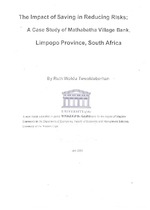| dc.contributor.author | Tewoldeberhan, Ruth W | |
| dc.date.accessioned | 2018-12-12T13:42:28Z | |
| dc.date.available | 2018-12-12T13:42:28Z | |
| dc.date.issued | 2003 | |
| dc.identifier.uri | http://hdl.handle.net/11394/6481 | |
| dc.description | Magister Commercii - MCom | en_US |
| dc.description.abstract | The minithesis argues that microfinance institutions help their clients by offering saving services, through which the clients will be able to get 'chunks of money' on a regular basis . These 'chunks of money' enable them to protect against emergency risks for it acts as a crisis-coping mechanism by building up the asset base in its physical, financial, human, and social sense. The accumulation of an asset base is not only critical in fighting risks ahead of time, but also enables poor clients to protect against losses afterwards . Thus the saving services provided by these institutions are essential in improving their clients' capacity to build up and manage their assets. | en_US |
| dc.publisher | University of the Western Cape | en_US |
| dc.subject | South Africa | en_US |
| dc.subject | Savings | en_US |
| dc.subject | Banking | en_US |
| dc.subject | Mathabatha | en_US |
| dc.subject | Limpopo province | en_US |
| dc.subject | Microfinance | en_US |
| dc.subject | Measuring savings | en_US |
| dc.subject | Micro-insurance | en_US |
| dc.subject | Economic vulnerability | en_US |
| dc.subject | Emergency risk | en_US |
| dc.subject | Village bank | en_US |
| dc.subject | Household economic portfolio | en_US |
| dc.subject | Poverty alleviation | en_US |
| dc.subject | Asset base | en_US |
| dc.subject | Economic empowerment | en_US |
| dc.title | The impact of saving in reducing risks: A case study of Mathabatha Village Bank, Limpopo province, South Africa | en_US |
| dc.rights.holder | University of the Western Cape | en_US |

